In the olden times there were float/arm sending units. they were terrible. I will not discuss them...
Most fuel senders in recent decades are 8 segment reed switch/hall effect sensors. They have a rod with 8 equally spaced sensors. They tell you the level of fuel based on the highest one that is under the surface of the fuel. So, if the fuel is between sensors, it tells you the lower one. It can't tell you anything below the bottom sensor. It can't tell you how much fuel is
above the highest sensor when you fill the tank.
In the picture, the example tank is divided in 4 equal heights (use your imagination because I didn't get the lines exact...) The top 3 hold equal volume of fuel but the bottom 1/4 holds less. Also the bottom 1/8 holds less than the 2nd 1/8th up.

So...fuel gauges display fuel "level" or "height" in the tank and there is dead space at the top and bottom. Also, the tank volume is not linear to height.
Fuel gauges have nothing to do with Gallons.
So NOBODY has a fuel gauge that works perfectly. Although a flat bottom tank would be more accurate.
Different models may have different V shapes and so different inaccuracies.
My point is...don't expect much. Learn what
your gauges look like at different volumes(gallons) of fuel.
Also, the tilt of the tank effects the "level" of the fuel at the rear of the tank where the sender is located. The tilt of the tank also effects how much you can "fill" the tank
I have two tanks. When I fill them I can burn almost 20 gallons from the main tank before the gauge even moves from FULL.
At "half" I am actually 10 or 15 gallons less than a true 1/2 tank.
The gauge readings on my two tanks (130 and 120) could not be more different. They are v bottom but one is tall (deep) and the other is long and shallow.
If you want to accurately know how many gallons of fuel you have, you must use your fuel burn calculations in your MFD.
If you have modern fuel injected motors your motor's computer very accurately measure fuel burn.
Your MFD uses this to "count down" fuel and to also give you calculated range.
When refueling you must Reset your Trip and tell it how much fuel you have added. If you forget to do that, you can use your Fuel Gauge as a fallback.


